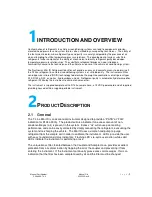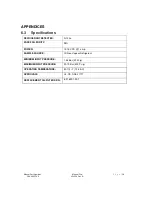
Manual Part Number:
5-06-4900-74-0
Manual File:
023524 Rev. A
P a g e
|
7
1
INTRODUCTION
AND
OVERVIEW
Contamination of refrigerants in vehicle air conditioning systems can lead to component corrosion,
elevated head pressures and system failures when utilized by unsuspecting technicians. The ability of
the technician to deter-mine refrigerant type and purity is severely hampered by the presence of air
when attempting to utilize temperature-pressure relations. The development of various substitute
refrigerants further complicates the ability of a technician to identify refrigerant purity based upon
temperature-pressure relationships. The substitute refrigerant blends can also introduce a
flammability hazard to the technician and the ultimate end user of the vehicle air conditioning system.
The Neutronics Mini ID Refrigerant Identifier will provide an easy and accurate means to determine if
the R134a refrigerant in vehicle air conditioning systems is of suitable purity. The instrument utilizes
non-dispersive infrared (NDIR) technology to determine the weight concentrations of refrigerant types
R12, R134a, R22, as well as, hydrocarbons and air. Refrigerant purity is automatically determined for
refrigerant R134a by the instrument to eliminate human error.
The instrument is supplied complete with a R134a sample hose, a 12 VDC power cord and all required
plumbing housed within a rugged, portable instrument.
2
P
RODUCT
D
ESCRIPTION
2.1
General
The T-Line Mini ID is an economical instrument designed to provide a “PASS” or “FAIL”
indication for R134a Purity. The product will also indicate if an excess amount of non-
condensable gas (air) is present in the system. Excess “air” will cause poor cooling
performance and can be easily corrected by simply recovering the refrigerant, evacuating the
system and re-charging the vehicle. The Mini ID uses a simple hand pump to purge
refrigerant from the sample cell in order to calibrate the instrument. LED’s pro-vide the user
with easy to understand status indicators. Flashing LED’s re-quire user action while solid
LED’s indicate the instrument is performing a task.
The unique brass filter, located between the Coupler and Sample Hose, provides excellent
protection from oil contamination by trapping the oil at the coupler and preventing it from
entering the instrument. If the instrument continually gives excess air messages, this is an
indication that the filter has been compromised by oil and the filter must be changed.














